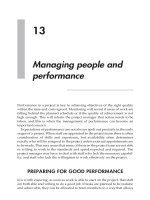Managing Ongoing Campaigns
Bạn đang xem bản rút gọn của tài liệu. Xem và tải ngay bản đầy đủ của tài liệu tại đây (420.58 KB, 10 trang )
Chapter 10
Managing Ongoing Campaigns
In This Chapter
ᮣ
Pausing and resuming campaigns and Ad Groups
ᮣ
Reactivating a slowed account
ᮣ
Reviving disabled keywords
ᮣ
Understanding geo-targeting
ᮣ
Setting up conversion tracking
T
his chapter is about the daily operation of AdWords campaigns. I empha-
size five important topics in this chapter:
ߜ Pausing and resuming campaigns and Ad Groups
ߜ Understanding why accounts are slowed, and knowing how to reactivate
a slowed account
ߜ Coping with slowed and disabled keywords, situations that can be baf-
fling to the uninitiated
ߜ Understanding and choosing geo-targeting
ߜ Implementing Google’s conversion tracking feature
Pausing and Resuming Portions
of Your Campaigns
One advantage of AdWords advertising is the control you have over stopping
and restarting portions of your marketing. Following are some reasons why
you might want to interrupt your advertising:
ߜ Budgetary. Your return on investment is suffering and your business is
leaking marketing dollars.
ߜ Assessment. You want data from different portions of your overall enter-
prise to settle without ongoing activity distorting your ROI calculations.
15_571435 ch10.qxd 5/21/04 11:35 PM Page 183
This factor is especially pertinent to affiliate marketing, in which the
marketer must balance site statistics, AdWords statistics, and reporting
statistics at the affiliate agency.
ߜ More assessment. You need time to catch your breath in AdWords,
survey the account, and analyze your ROI.
ߜ Breakdown. Not your breakdown, I hope, but the breakdown of some
portion of your AdWords effort. You may stop and restart elements of
your campaign down to the Ad Group level. You may also delete key-
words, but you can’t pause and resume keywords short of plucking them
out entirely and then building them back in.
The pause-and-resume system in AdWords allows you to stop activity without
losing settings. The system responds quickly, if not quite instantaneously.
However, it can take up to three hours for reporting statistics in the Control
Center to catch up with paused reality. When a campaign is running, of
course, statistics never catch up to reality — there’s always a lag of no more
than three hours.
Little instruction is required for pausing campaigns and Ad Groups. In the
case of campaigns, you can do the job from the top page of the Campaign
Management tab, like this:
1. Click the Campaign Management tab.
2. Use the check boxes to select one or more campaigns you want to
pause.
3. Click the Pause button.
You pause and resume Ad Groups in the same manner, but from the Ad Group
page. Specifically:
1. Click the Campaign Management tab.
2. In the Campaign Name column, click any campaign.
3. Use the check boxes to select one or more Ad Groups.
4. Click the Pause or Resume button.
Paused campaigns and Ad Groups continue to display their statistics (see
Figure 10-1) and to contribute those numbers to your account or campaign
totals. However, the display of those statistics is date-sensitive. So if you use
the date menus to specify a day in which some Ad Groups were paused for
the entire day, those Ad Groups show no data.
184
Part II: Creating and Managing an AdWords Campaign
15_571435 ch10.qxd 5/21/04 11:35 PM Page 184
Repairing Broken Campaigns
Sometimes things can go wrong. Specifically, Google puts its nose in your
account, inhibiting the distribution of your ads. This grim fact is frustrating
at first to nearly every advertiser, but it’s all in the cause of relevance, which
in the end is the key to everyone’s success.
Things can go wrong with your marketing effort that have nothing to do with
Google’s intrusions and corrections. You might not convert leads to sales on
your site. You might spend too much for clickthroughs, generating high click-
through rates (CTRs) but dragging down your return on investment (ROI).
These issues seek a variety of solutions ranging from product pricing to site
design to advertising strategy. The purpose of this section is to show you how
to deal with the problems that arise and are solved in the AdWords Control
Center, namely, recovering from slowed and disabled account elements.
Figure 10-1:
Paused Ad
Groups
continue
showing
statistics
and
contributing
them to the
bottom line.
185
Chapter 10: Managing Ongoing Campaigns
15_571435 ch10.qxd 5/21/04 11:35 PM Page 185
Reactivating a slowed account
Google puts the brakes on your campaigns for one basic reason: low CTR.
Google assesses your clickthrough rate on two extreme levels: keyword by
keyword and account-wide. For the most part, Google begins these measure-
ments after 1000 impressions. Under certain circumstances (for example,
after a disabled keyword is reinstated), fewer impressions are counted. If
your account’s total CTR is below the threshold of 0.5 percent, which neces-
sarily means some of your keywords are below that level, Google might
(probably will) slow the account. If the overall account CTR is acceptable,
Google slows individual keywords when they don’t perform up to spec.
When the account is slowed, the Control Center displays a notice. You may
reactivate the account whenever you like with a single click of the button in
the notice. Every third time you do so, Google charges your account five dol-
lars. Nearly everyone accrues a few of those charges, but be careful about
reactivating the account without correcting the problem, which resides in
your Ad Group(s). Fixing troublesome keyword performance is a matter of
discarding the keyword, rewriting the ad with which the keyword is associ-
ated, changing the matching option of the keyword, or adjusting the bid
amount to encourage a higher clickthrough rate. These creative issues are
discussed in Chapters 8 and 9.
Recovering disabled keywords
Google never stops the activity of an advertiser’s entire account, though it
does slow the distribution of all ads when the account isn’t performing well.
At the keyword level, Google does stop ad distribution completely when an
ad is failing on its keywords’ search pages. Three factors must correspond to
motivate Google to disable a keyword:
ߜ The associated ad must accrue at least 1000 impressions, unless it’s a
formerly disabled keyword in use again.
ߜ The CTR must fall below 0.5 percent for ads in the top page position or
below slightly lower thresholds for lower positions.
ߜ The performance meltdown must happen on Google.com, regardless of
the ad’s performance on the extended distribution networks.
Google first issues the At risk warning in the Status column of the Ad Group
page, as described and illustrated in Chapter 9. Google might also slow the
ads associated with the failing keyword. Then, if you make no corrections,
Google lowers the boom and disables the keyword, meaning that ads associ-
ated with that keyword no longer appear on any pages in Google and
throughout the extended networks.
186
Part II: Creating and Managing an AdWords Campaign
15_571435 ch10.qxd 5/21/04 11:35 PM Page 186
Following are two facts to know when a keyword is disabled:
ߜ Keywords in good standing continue operating at full throttle, triggering
the appearance of your ads.
ߜ Keyword phrases that include a keyword that is failing elsewhere in the
account are slowed along with the failing keyword, even if those phrases
are performing well in their Ad Groups. So, if the keyword mp3 is dis-
abled, the phrase portable mp3 player is disabled also, no matter where
it is used in your account.
187
Chapter 10: Managing Ongoing Campaigns
When bad things happen to good keywords
Not uncommonly, Google slows or disables key-
words that appear to be thriving. This phenom-
enon is a source of mystery to new advertisers,
who watch in horror as Google takes their best
keywords out of play. The advertiser’s best key-
words are not necessarily Google’s best key-
words. The reason for this contradictory
scenario is that Google computes the deciding
CTR on advertising performance on Google’s
search pages only. It does not factor in ad per-
formance on its search or content partner sites.
If an advertiser chooses to distribute ads to the
search network and content network (in
Campaign settings), the Control Center’s statistics
for the campaign total all metrics generated
throughout the networks. Ironically, Google does-
n’t break out the important numbers regarding
performance in Google. Instead, Google imple-
ments the “At risk” warning system — a surpris-
ingly blunt tool in an otherwise laser-sharp
reporting environment.
Frustration can run high when good, productive,
profitable keywords are disabled. I’ve seen key-
words with an overall CTR above 3.0 fall under
the knife because their hidden performance
numbers on Google were below the 0.5 thresh-
old. The question naturally arises, Why do some
ads perform so well outside Google and so
poorly on Google search pages? Several reasons
contribute to this puzzle. Important sites in the
extended networks display ads differently from
Google, and those display differences can work
favorably for certain ads. Perhaps consumers
are more accustomed to the presence of adver-
tising in Google than on other sites. Whatever the
reasons, expect to run into the situation.
The AdWords community has buzzed with com-
plaint about this issue, wondering why adver-
tisers are not offered a choice of getting off
Google’s pages entirely. If advertisers are
allowed to opt in and out of the Google Network,
why not the home site? After all, when robust
keywords are disabled because of Google-only
performance, everybody loses — the adver-
tiser, the search network owners, the content
publishers, and Google.
15_571435 ch10.qxd 5/21/04 11:35 PM Page 187









